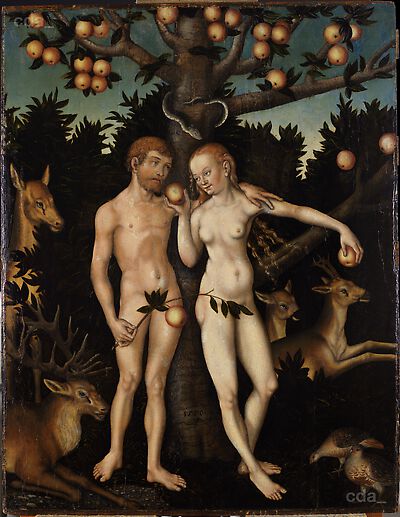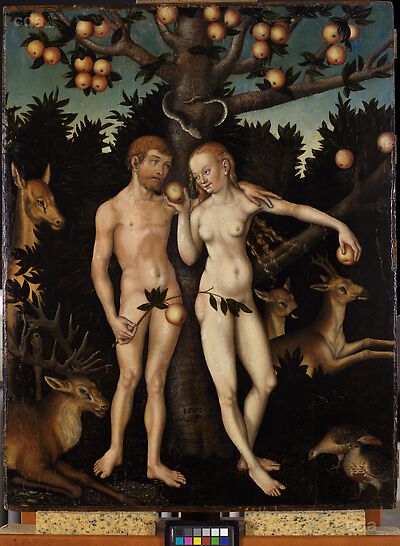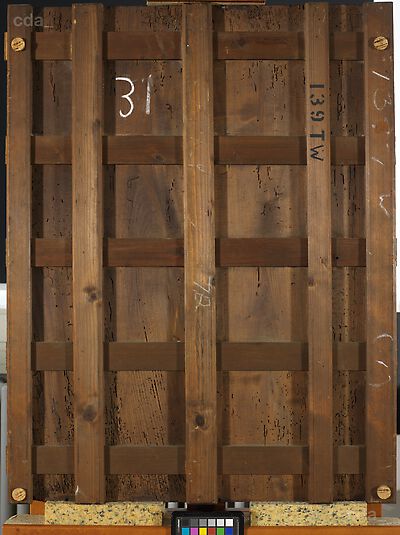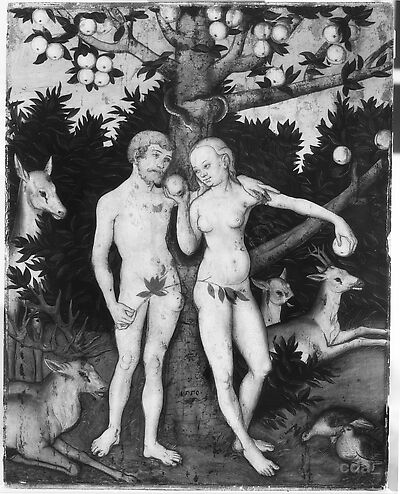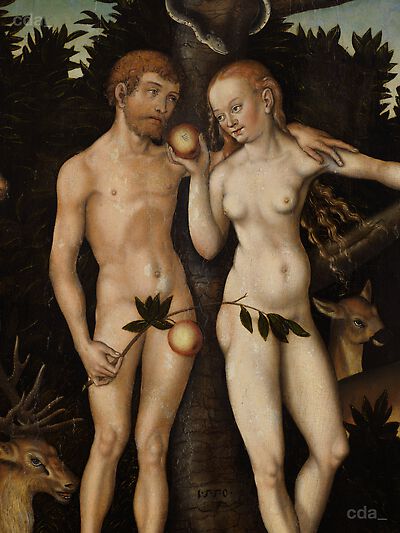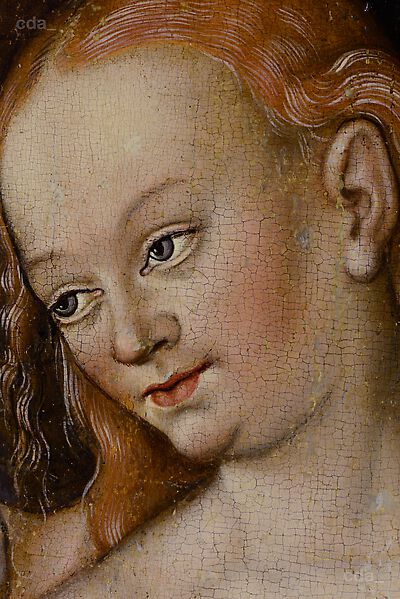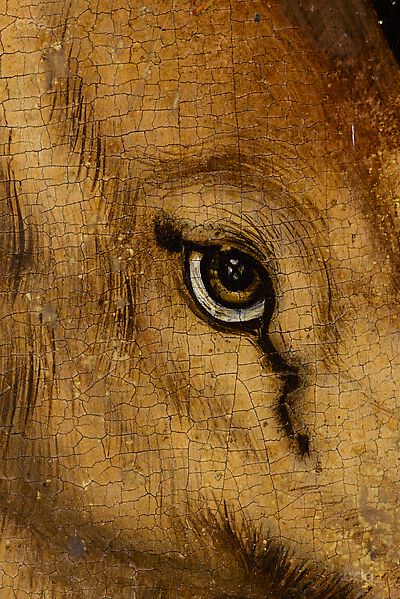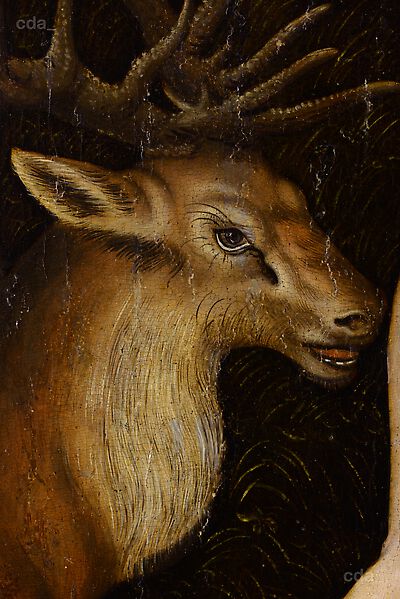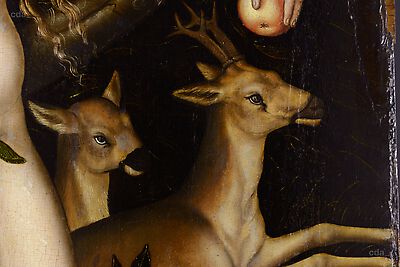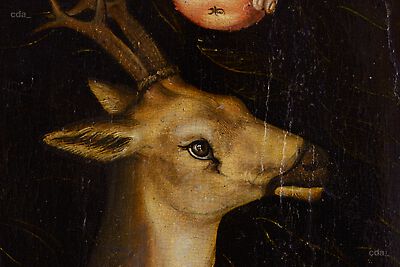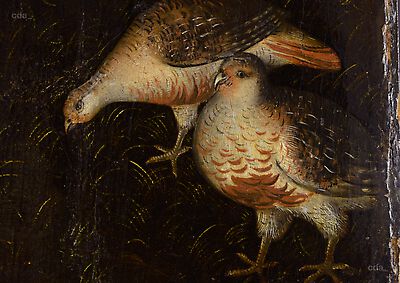Support
'The panel probably consists of two vertically aligned soft wood planks. Due to the cradle on the reverse the join is not clearly visible in the x-radiograph. Knots have been retained in the wood. The reverse of the panel has been thinned at a later date. [..]
The support is a wooden panel that corresponds closely in size to the standard format ‚D’, which was often used in Cranach's workshop. However, coniferous wood was rarely used in the Wittenberg workshop for panels of smaller sizes.'
Ground and Imprimatura
'The panel has a white ground on the recto. A barbe is present along all four edges and confirms that the panel has survived in its original size. There is an incised line on the top running parallel to the edge of the panel.'
Underdrawing
'Infrared reflectography reveals dark lines executed with a brush and a fluid, black medium to fix contours and faces. Some contours exhibit searching lines. There are only minor deviations visible between the underdrawing and the final painted version. [...]
Underdrawings executed with a black fluid medium and a brush were for many decades frequently used by Lucas Cranach and his workshop members. However, around 1550 dry media (black and red ‘chalk’) were preferred in Cranach’s workshop.
The style of underdrawing with clearly deliniated contours corresponds with works by Wolfgang Krodel, who was trained in Cranach's workshop and who worked from around 1528 in Schneeberg.'
Paint Layers and Gilding
'Elements in the paint were detected using XRF analysis. In combination with the visual appearance of the paint the following pigments and fillers were identified, in summary: lead white, lead tin yellow I, iron oxide/ochre, vermilion, azurite, copper based green pigment.
The verification of the presence of calcium suggests the use of calcium carbonate (chalk) in the ground or/ and as a fill material or substrate. In addition zinc was detected in minor quantities at numerous measuring points. Here zinc white was possibly employed for retouching or zinc is present as a trace element in the original paint.
The flesh tones were modulated employing light and pinkish flesh paint and greyish brown shadow tones. Some contours and in particular the eyes were completed with black outlines. Both figures appear skillfully executed. The execution of the landscape was begun with the blue sky and a black underlayer for foliage and grass on which leaves and blades were painted, mainly with yellow-green highlights and greenish as well as (discoloured?) brownish glazes. The animals also appear to have been routinely executed. The reflected light in the pupils of their eyes is divided into four and thus reflects the mullion and transom of a cross window although the animals are depicted in a landscape. Each shape was executed with a clearly designated outline and little alternating overlapping. No considerable compositional changes are visible in the X-radiograph. [...]
The identified pigments were regularly employed in northern European panel paintings before 1750 and were also frequently used in the Cranach workshop as well as by assistants who had left the workshop. Techniques for the paint application correspond with the usual practice in the Cranach workshop. The layer structure, the forms and the design elements employed here can be found on other Wittenberg workshop productions. The reflected light in the pupils of the animal’s eyes that is divided into four and thus reflects the mullion and transom of a cross window can be found on works by Cranach and his assistants, as for example Adam and Eve in a Landscape, after 1537(BE_MRBAB_2627). Although the original quality of the execution is compromised in many areas due to damage, the execution also corresponds in quality with other works by assistants of the Cranach workshop.
The panel is dated ‘1·5·5·0·’ with black paint on the tree trunk. The paint has not run into the craquelure, meaning it was most probably applied to the image when it was created.'
[unpublished examination report G. Heydenreich, 2019]
